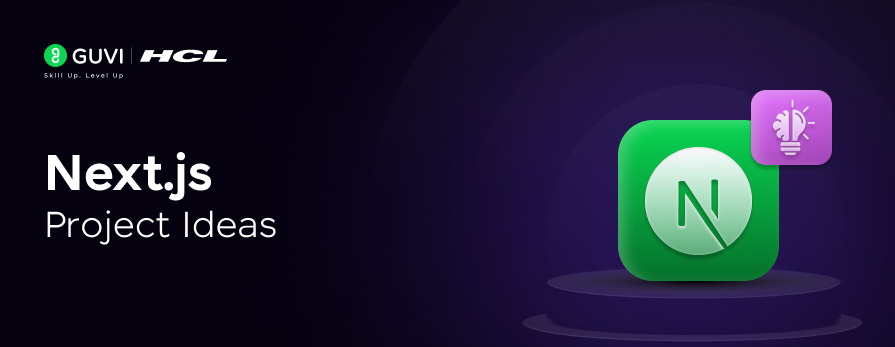
Top 15+ Next.js Projects with Source Code
Jul 01, 2025 7 Min Read 17962 Views
(Last Updated)
Are you searching for Next.js project ideas to elevate your web development skills? Whether you’re just starting out or looking to enhance your portfolio, exploring real-world projects is a great way to master the Next.js project structure.
From basic to advanced, each project listed here comes with source code and detailed insights to help you build modern, scalable applications.
In this list, I have made sure to include projects for everyone, be it a simple To-Do Application or a complex Social Networking Platform. By the end, you’ll have a diverse set of Next.js projects that demonstrate your proficiency to potential employers or clients.
Table of contents
- The 18 Best Next.js Project Ideas from Beginner to Expert [With Source Code]
- Personal Blog Application
- To-Do Application
- Contact Us Form
- E-Commerce App
- Social Networking Platform
- Music Player App
- Cryptocurrency Tracker
- In-App Notification System
- Social Media Dashboard
- E-commerce Dashboard
- Real Estate Listings Platform
- Recipe Generator
- Build a Notes App
- Calculator App
- Expense Tracker
- Dictionary App
- Weather Monitoring Dashboard
- Daily Activity Planner App
- Final Words
- FAQs
- What are the easy Next.js project ideas for beginners?
- Why are Next.js projects important for beginners?
- What skills can beginners learn from Next.js projects?
- Which Next.js project is recommended for someone with no prior programming experience?
- How long does it typically take to complete a beginner-level Next.js project?
The 18 Best Next.js Project Ideas from Beginner to Expert [With Source Code]
These 18 Next.js projects have been carefully selected to cater to developers of all skill levels, from beginners to experts.
Each project demonstrates unique technical concepts like API integration, state management, and server-side rendering, offering practical hands-on experience with Next.js in real-world applications.
1. Personal Blog Application
This project focuses on creating a fully functional blog with Next.js that supports dynamic content, server-side rendering, and SEO enhancements. By building this blog application, users can learn how to handle dynamic routing, Markdown-based content management, and styling with TailwindCSS.
The project also introduces content management practices with CMS integration, making it a perfect starting point for anyone interested in content-rich applications.
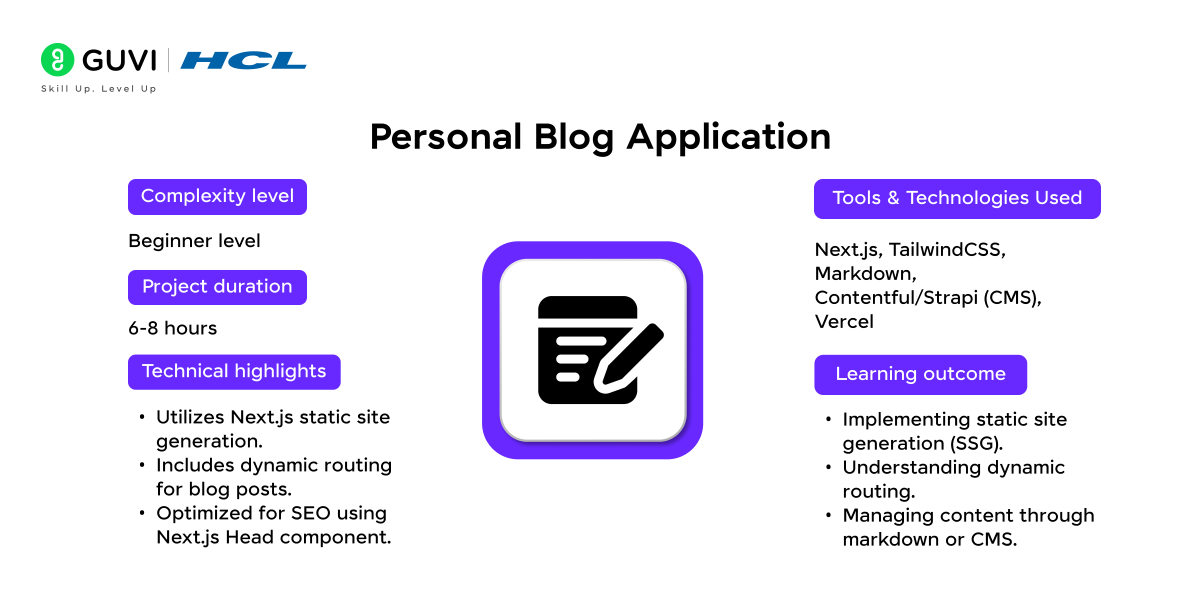
Project Complexity: Beginner
Development Time: 6-8 hours
Integration with APIs: Not required
Tools and Technologies used: Next.js, TailwindCSS, Markdown, Contentful/Strapi (CMS), Vercel
Technical Highlights:
- Utilizes Next.js static site generation.
- Includes dynamic routing for blog posts.
- Optimized for SEO using Next.js Head component.
Learning Outcomes:
- Implementing static site generation (SSG).
- Understanding dynamic routing.
- Managing content through markdown or CMS.
Source Code: GitHub Repository
2. To-Do Application
Building a To-Do app with Next.js teaches essential CRUD (Create, Read, Update, Delete) functionalities, including managing state with React hooks. This app is ideal for learning about user interaction, state persistence using localStorage, and component-based design principles.
It’s an excellent project for beginners to get comfortable with data handling and interactive elements in Next.js.
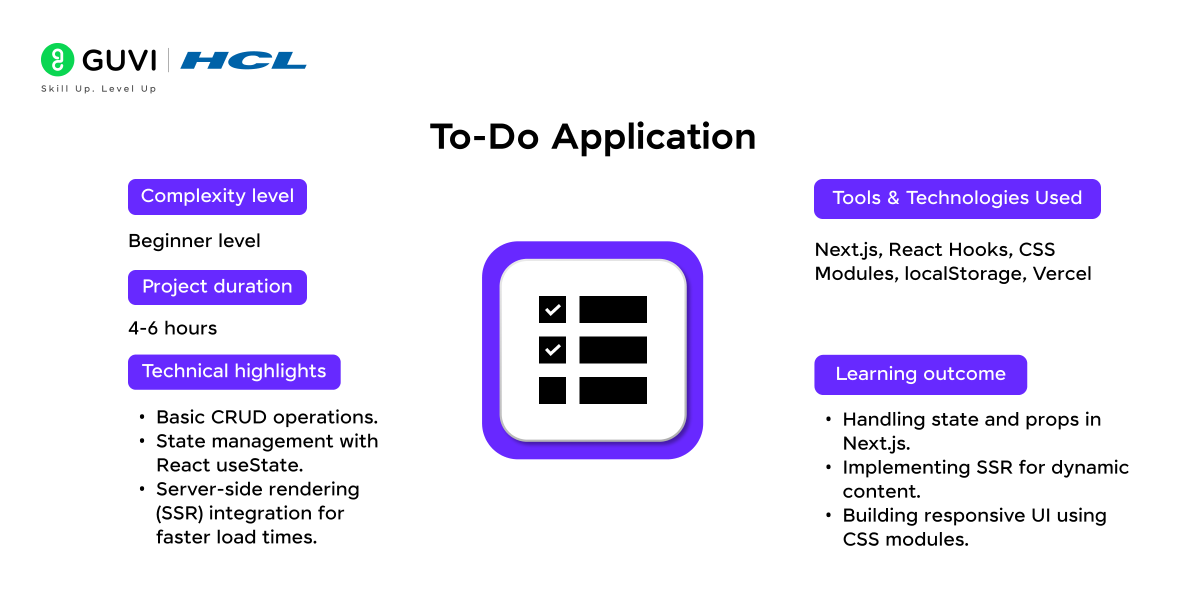
Project Complexity: Beginner
Development Time: 4-6 hours
Integration with APIs: Optional
Tools and Technologies used: Next.js, React Hooks, CSS Modules, localStorage, Vercel
Technical Highlights:
- Basic CRUD operations.
- State management with React useState.
- Server-side rendering (SSR) integration for faster load times.
Learning Outcomes:
- Handling state and props in Next.js.
- Implementing SSR for dynamic content.
- Building a responsive UI using CSS modules.
Source Code: GitHub Repository
3. Contact Us Form
The Contact Us form project emphasizes form handling and backend communication using Next.js API routes. By developing this project, users can explore input validation, conditional rendering, and email API integration to handle form submissions.
It’s a practical project for any beginner looking to understand the fundamentals of handling user data securely.
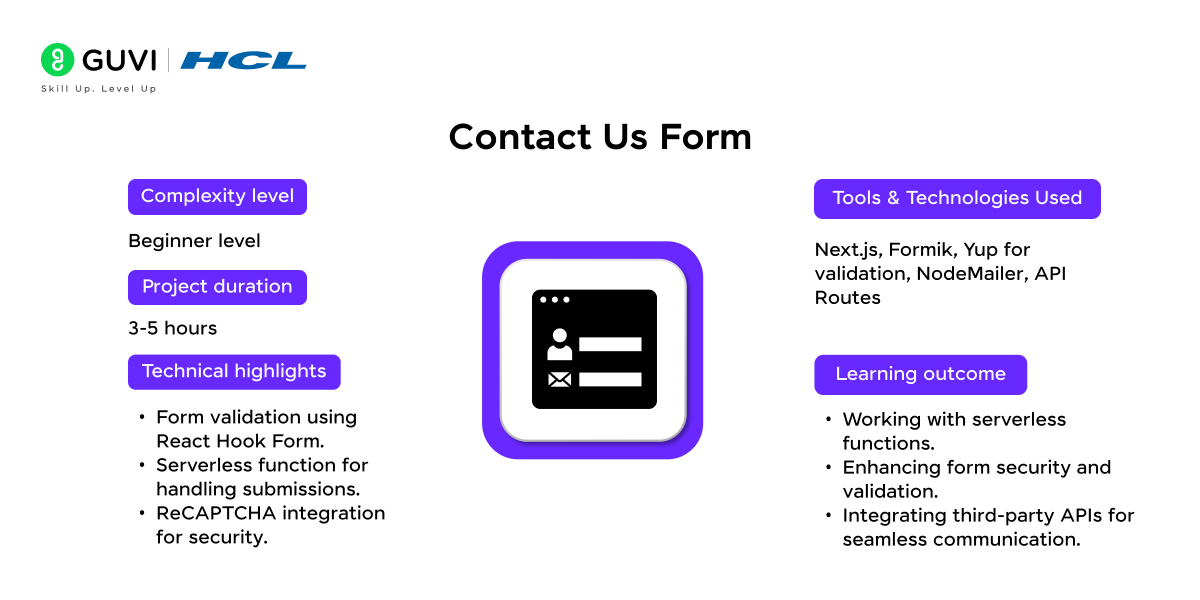
Project Complexity: Beginner
Development Time: 3-5 hours
Integration with APIs: Email API (e.g., SendGrid)
Tools and Technologies used: Next.js, Formik, Yup for validation, NodeMailer, API Routes
Technical Highlights:
- Form validation using React Hook Form.
- Serverless function for handling submissions.
- ReCAPTCHA integration for security.
Learning Outcomes:
- Working with serverless functions.
- Enhancing form security and validation.
- Integrating third-party APIs for seamless communication.
Source Code: GitHub Repository
4. E-Commerce App
Create a sophisticated e-commerce platform with Next.js that features product listings, a shopping cart, and checkout functionality with Stripe. This project covers everything from setting up dynamic routing to working with databases for managing products, making it ideal for intermediate-level learners.
It provides hands-on experience with server-side rendering, API integration, and secure payment processing.
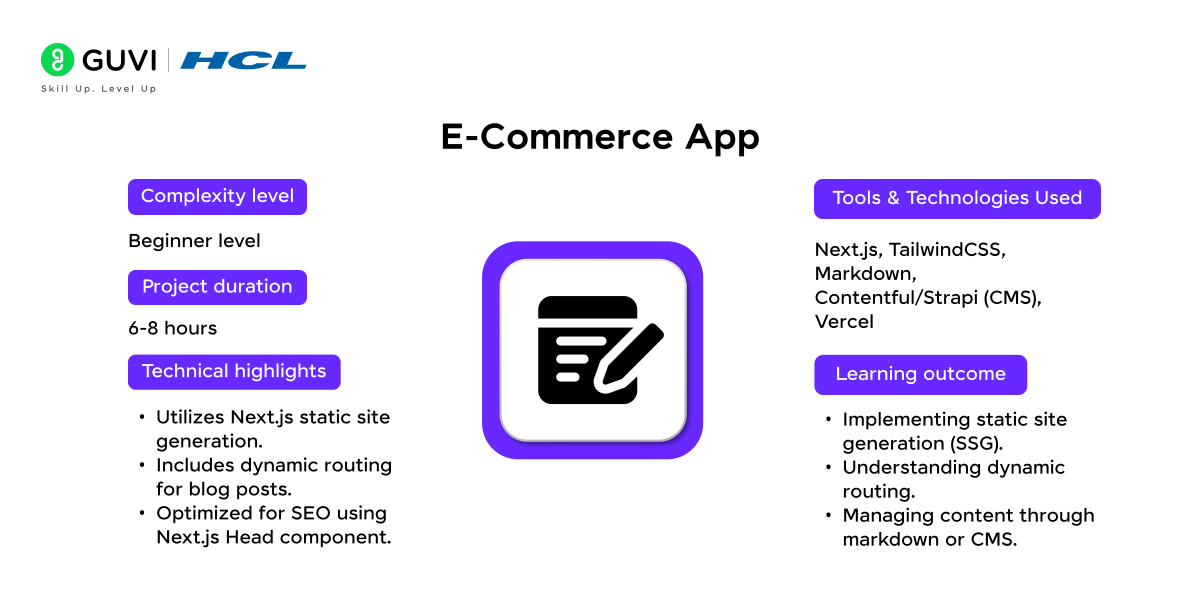
Project Complexity: Intermediate
Development Time: 20-25 hours
Integration with APIs: Stripe for payments
Tools and Technologies used: Next.js, Redux Toolkit for state management, Stripe API, TailwindCSS, MongoDB
Technical Highlights:
- Product listings and cart functionality.
- Secure payment gateway using Stripe.
- Real-time data fetching with SWR.
Learning Outcomes:
- Advanced API integration.
- Managing user authentication.
- Building complex state management systems.
Source Code: GitHub Repository
5. Social Networking Platform
Build a scalable social networking app where users can create profiles, post content, and engage with others. This project demonstrates the power of Next.js in handling complex state management and real-time data.
Key learning outcomes include WebSocket implementation, user authentication, and the use of Firestore or MongoDB for database management. It’s a great choice for advanced users wanting to tackle social features in web development.
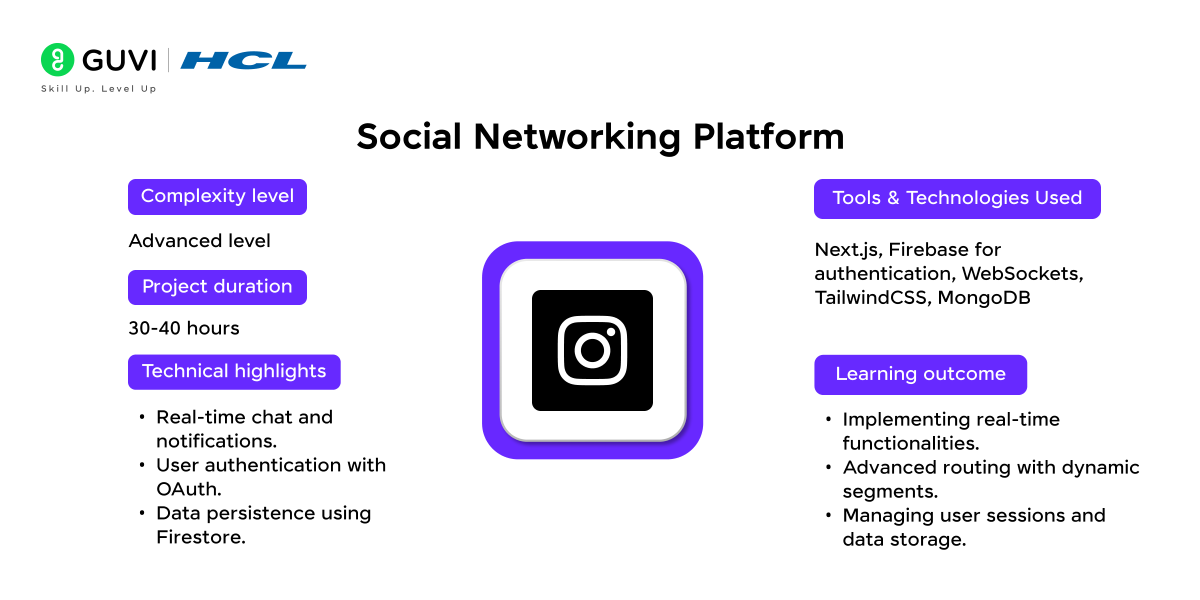
Project Complexity: Advanced
Development Time: 30-40 hours
Integration with APIs: Firebase for backend services
Tools and Technologies used: Next.js, Firebase for authentication, WebSockets, TailwindCSS, MongoDB
Technical Highlights:
- Real-time chat and notifications.
- User authentication with OAuth.
- Data persistence using Firestore.
Learning Outcomes:
- Implementing real-time functionalities.
- Advanced routing with dynamic segments.
- Managing user sessions and data storage.
Source Code: GitHub Repository
6. Music Player App
The Music Player App project uses Next.js to create a responsive, interactive music interface with playlist and playback controls. This project involves API integration with Spotify or YouTube for accessing music data and focuses on managing asynchronous data and custom audio controls. It’s a fun project for learners interested in media applications and responsive design.
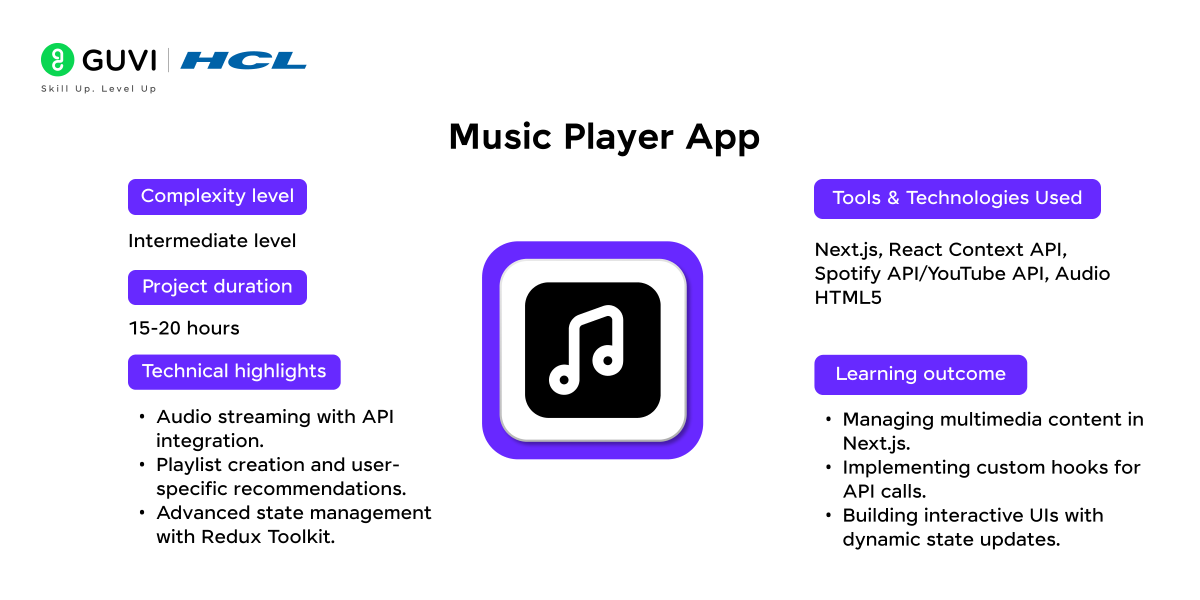
Project Complexity: Intermediate
Development Time: 15-20 hours
Integration with APIs: Spotify or YouTube API
Tools and Technologies used: Next.js, React Context API, Spotify API/YouTube API, Audio HTML5
Technical Highlights:
- Audio streaming with API integration.
- Playlist creation and user-specific recommendations.
- Advanced state management with Redux Toolkit.
Learning Outcomes:
- Managing multimedia content in Next.js.
- Implementing custom hooks for API calls.
- Building interactive UIs with dynamic state updates.
Source Code: GitHub Repository
7. Cryptocurrency Tracker
This project aims to build a cryptocurrency tracker that displays live price data, charts, and news updates. Using Next.js, developers can learn about API integration and real-time data fetching with services like CoinGecko or CoinMarketCap.
Additionally, this project is an excellent way to practice data visualization techniques and dynamic content handling.
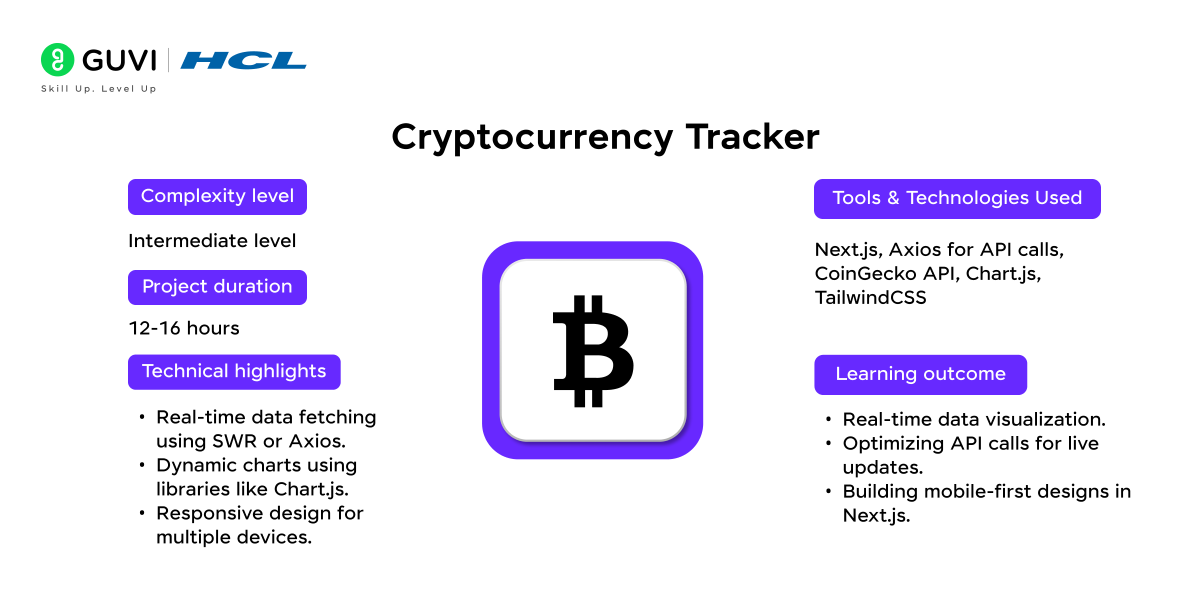
Project Complexity: Intermediate
Development Time: 12-16 hours
Integration with APIs: CoinGecko or CryptoCompare API
Tools and Technologies used: Next.js, Axios for API calls, CoinGecko API, Chart.js, TailwindCSS
Technical Highlights:
- Real-time data fetching using SWR or Axios.
- Dynamic charts using libraries like Chart.js.
- Responsive design for multiple devices.
Learning Outcomes:
- Real-time data visualization.
- Optimizing API calls for live updates.
- Building mobile-first designs in Next.js.
Source Code: GitHub Repository
8. In-App Notification System
Create a system that sends real-time notifications to users, utilizing technologies like Firebase or WebSockets in combination with Next.js. This project helps learners understand the basics of real-time communication and push notifications, which are valuable skills for applications that require instant updates or alerts.
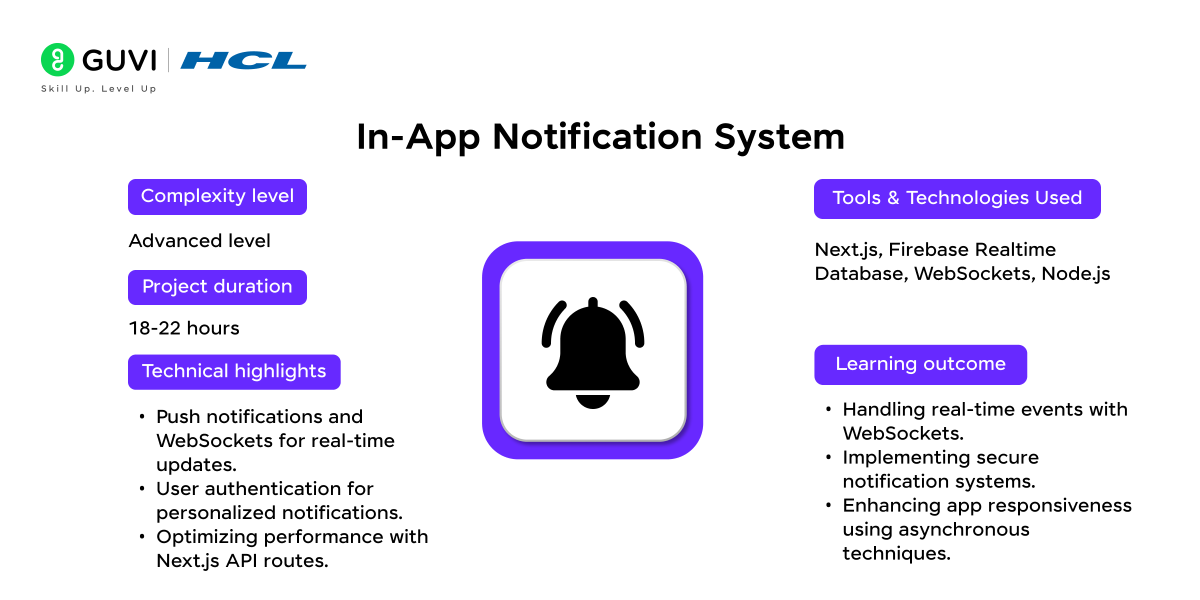
Project Complexity: Advanced
Development Time: 18-22 hours
Integration with APIs: Firebase Cloud Messaging
Tools and Technologies used: Next.js, Firebase Realtime Database, WebSockets, Node.js
Technical Highlights:
- Push notifications and WebSockets for real-time updates.
- User authentication for personalized notifications.
- Optimizing performance with Next.js API routes.
Learning Outcomes:
- Handling real-time events with WebSockets.
- Implementing secure notification systems.
- Enhancing app responsiveness using asynchronous techniques.
Source Code: GitHub Repository
9. Social Media Dashboard
A social media dashboard aggregates analytics from various social platforms, allowing users to track and visualize metrics in a single interface. This project covers API authentication and authorization, using OAuth for social media APIs, and data visualization with charting libraries.
It’s an excellent choice for those looking to work on dashboard interfaces and multi-source data integration.
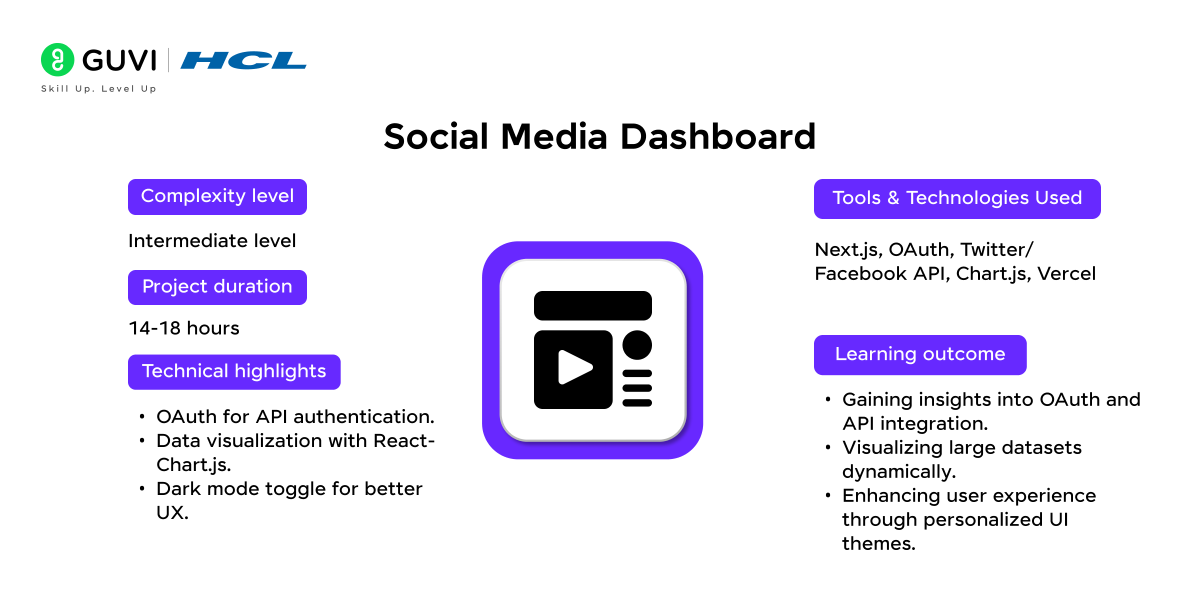
Project Complexity: Intermediate
Development Time: 14-18 hours
Integration with APIs: Facebook, Twitter, or Instagram API
Tools and Technologies used: Next.js, OAuth, Twitter/Facebook API, Chart.js, Vercel
Technical Highlights:
- OAuth for API authentication.
- Data visualization with React-Chart.js.
- Dark mode toggle for better UX.
Learning Outcomes:
- Gaining insights into OAuth and API integration.
- Visualizing large datasets dynamically.
- Enhancing user experience through personalized UI themes.
Source Code: GitHub Repository
Looking to master Next.js and build dynamic web applications? GUVI’s Next.js Course offers hands-on learning with real-world projects, helping you develop skills in server-side rendering, API integration, and performance optimization.
Gain practical experience using top tools like React, Vercel, and TailwindCSS, while benefiting from expert guidance and lifetime access to course content. Perfect for learners aiming to advance in web development.
10. E-commerce Dashboard
Create an admin dashboard to manage product inventories, sales analytics, and customer orders. This project is useful for learning about role-based access, real-time data updates, and API integration in Next.js.
It is especially relevant for developers who want to explore backend integrations and administrative tools in web applications.
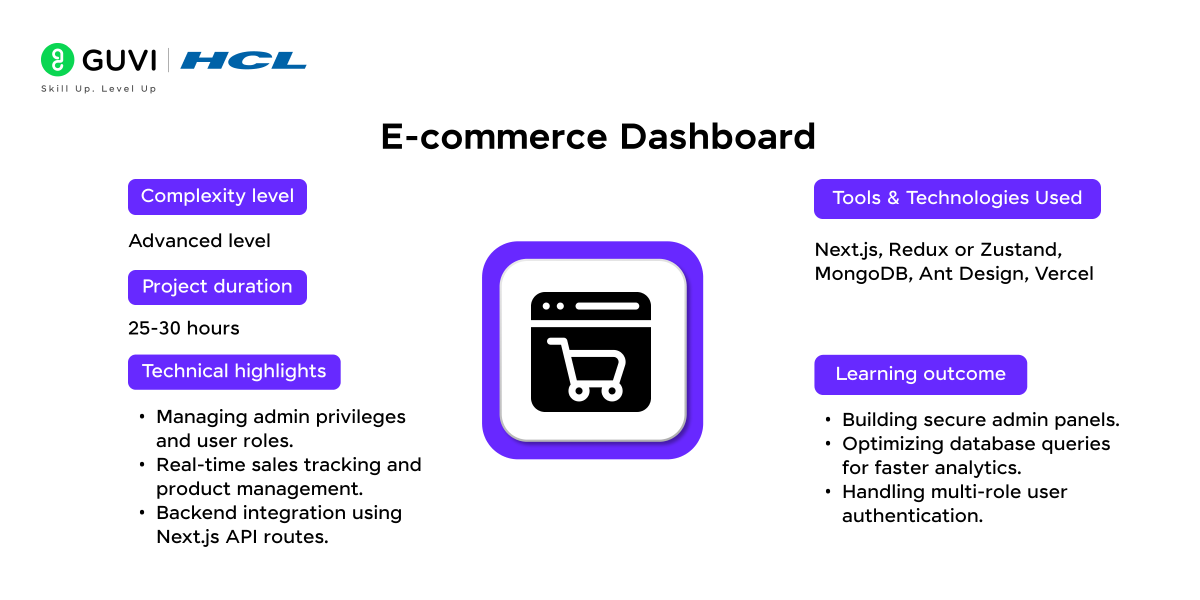
Project Complexity: Advanced
Development Time: 25-30 hours
Integration with APIs: Stripe, PayPal for payment analytics
Tools and Technologies used: Next.js, Redux or Zustand, MongoDB, Ant Design, Vercel
Technical Highlights:
- Managing admin privileges and user roles.
- Real-time sales tracking and product management.
- Backend integration using Next.js API routes.
Learning Outcomes:
- Building secure admin panels.
- Optimizing database queries for faster analytics.
- Handling multi-role user authentication.
Source Code: GitHub Repository
11. Real Estate Listings Platform
Build a responsive real estate listing platform that allows users to search for properties, apply filters, and view property details on an interactive map.
This project emphasizes server-side rendering, API usage for location-based services, and SSR (Server-Side Rendering) for SEO optimization, making it ideal for intermediate developers interested in building directory-style applications.
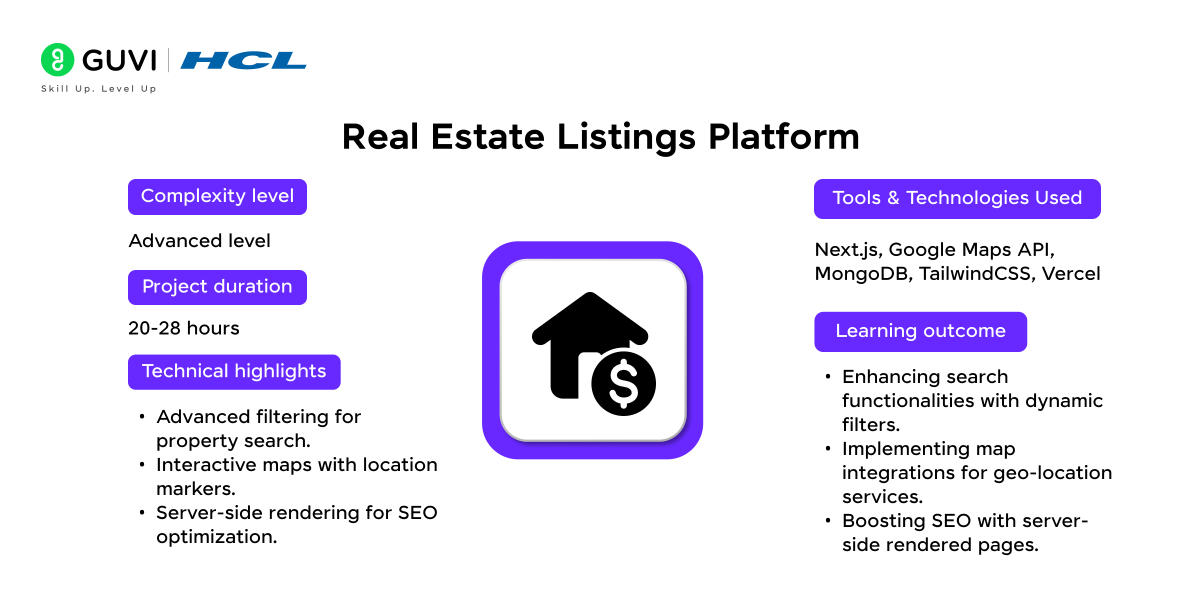
Project Complexity: Advanced
Development Time: 20-28 hours
Integration with APIs: Zillow, Google Maps API
Tools and Technologies used: Next.js, Google Maps API, MongoDB, TailwindCSS, Vercel
Technical Highlights:
- Advanced filtering for property search.
- Interactive maps with location markers.
- Server-side rendering for SEO optimization.
Learning Outcomes:
- Enhancing search functionalities with dynamic filters.
- Implementing map integrations for geo-location services.
- Boosting SEO with server-side rendered pages.
Source Code: GitHub Repository
12. Recipe Generator
The Recipe Generator is an interactive app where users can input ingredients to receive recipe suggestions.
This project showcases Next.js’s capability to handle dynamic content and external API calls. It’s a great choice for those wanting to explore filtering, state management, and real-time data handling in a fun, food-centric application.
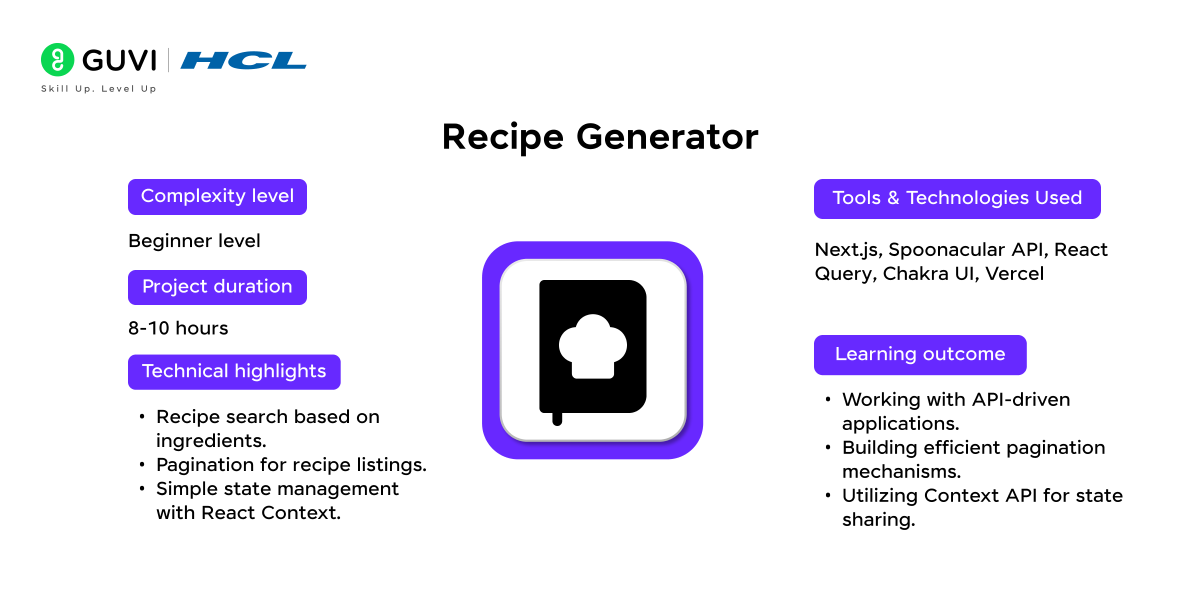
Project Complexity: Beginner
Development Time: 8-10 hours
Integration with APIs: Spoonacular API
Tools and Technologies used: Next.js, Spoonacular API, React Query, Chakra UI, Vercel
Technical Highlights:
- Recipe search based on ingredients.
- Pagination for recipe listings.
- Simple state management with React Context.
Learning Outcomes:
- Working with API-driven applications.
- Building efficient pagination mechanisms.
- Utilizing Context API for state sharing.
Source Code: GitHub Repository
13. Build a Notes App
A minimalist notes app provides a structured environment for creating and storing notes, with options for markdown support and dark mode. Using Next.js, this project focuses on data persistence, component-based structure, and UI design.
It’s perfect for beginners learning about custom hooks and localStorage to maintain application state across sessions.
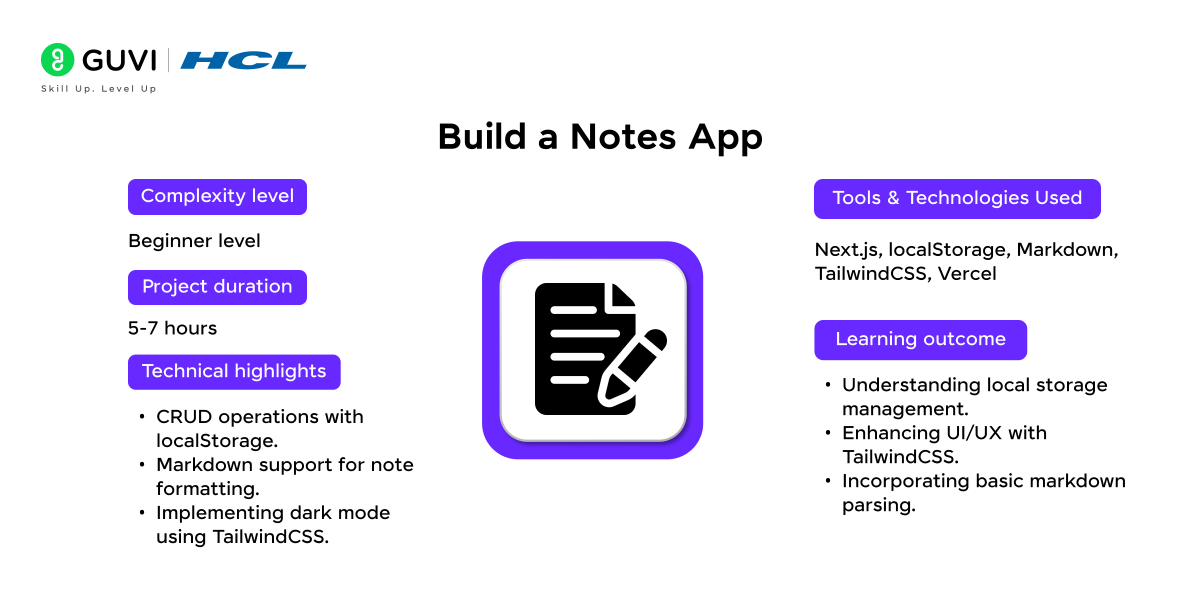
Project Complexity: Beginner
Development Time: 5-7 hours
Integration with APIs: Optional
Tools and Technologies used:
Technical Highlights: Next.js, localStorage, Markdown, TailwindCSS, Vercel
- CRUD operations with localStorage.
- Markdown support for note formatting.
- Implementing dark mode using TailwindCSS.
Learning Outcomes:
- Understanding local storage management.
- Enhancing UI/UX with TailwindCSS.
- Incorporating basic markdown parsing.
Source Code: GitHub Repository
14. Calculator App
Build a simple calculator to learn state handling, event management, and basic arithmetic operations in Next.js. This project may be simple, but it is effective for beginners who want to understand component interaction and responsive layouts.
It’s an ideal introduction to managing inputs and outputs in a web application.
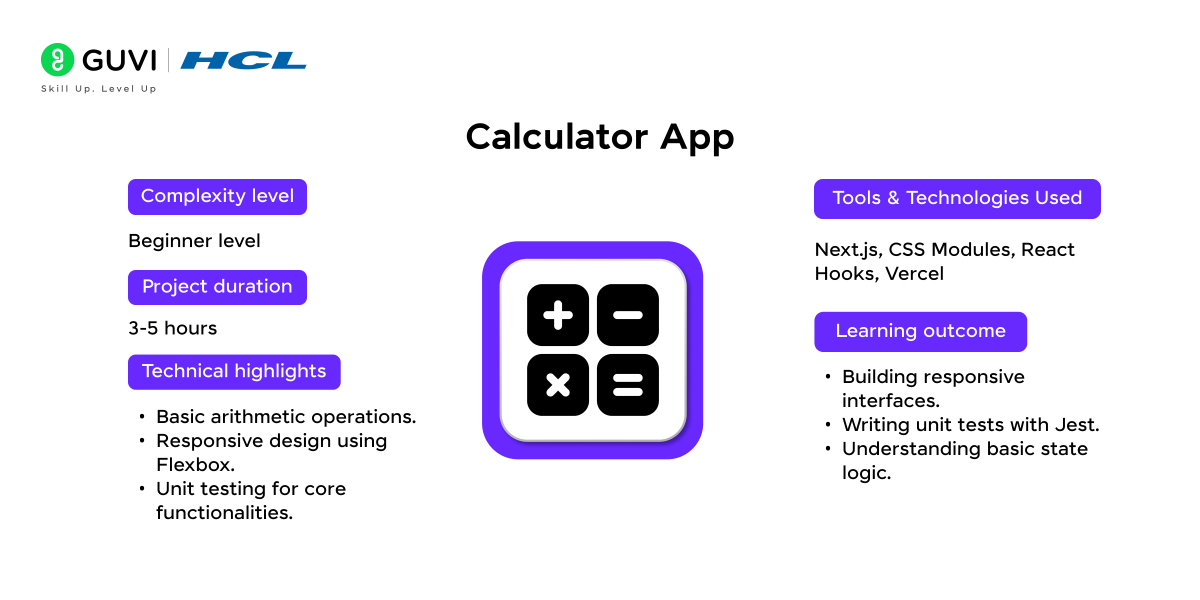
Project Complexity: Beginner
Development Time: 3-5 hours
Integration with APIs: Not required
Tools and Technologies used: Next.js, CSS Modules, React Hooks, Vercel
Technical Highlights:
- Basic arithmetic operations.
- Responsive design using Flexbox.
- Unit testing for core functionalities.
Learning Outcomes:
- Building responsive interfaces.
- Writing unit tests with Jest.
- Understanding basic state logic.
Source Code: GitHub Repository
15. Expense Tracker
An expense tracker records income and expenses, offering visual charts to analyze spending patterns. This Next.js project integrates Firebase for real-time updates and uses charting libraries to visualize financial data.
It’s a practical choice for those interested in data visualization, database connectivity, and responsive UI design.
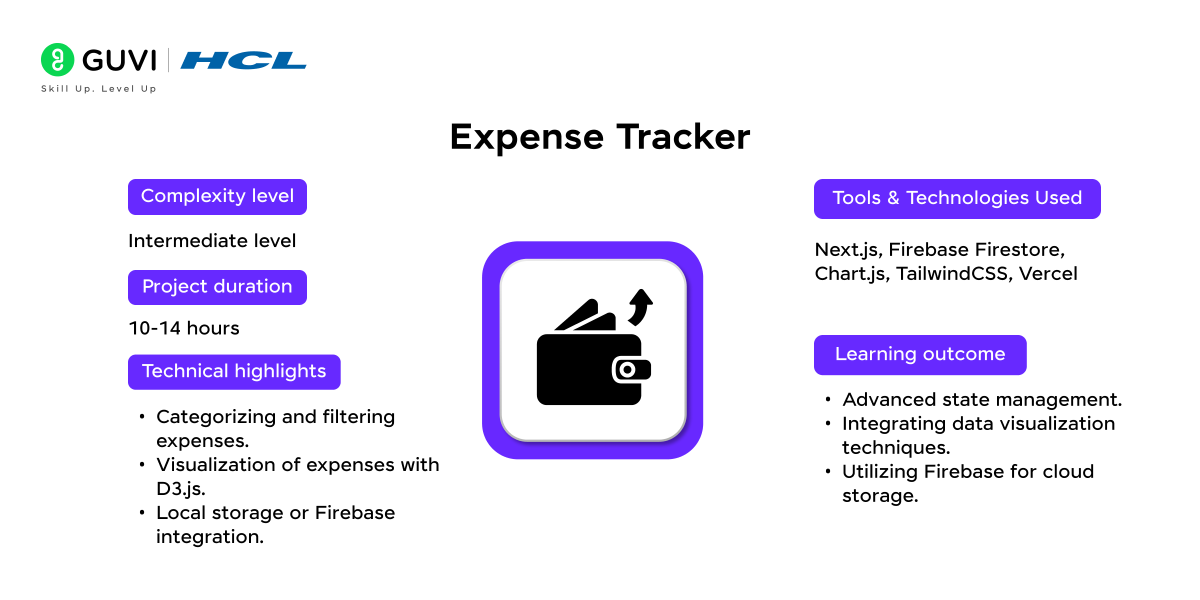
Project Complexity: Intermediate
Development Time: 10-14 hours
Integration with APIs: Optional for currency conversion
Tools and Technologies used: Next.js, Firebase Firestore, Chart.js, TailwindCSS, Vercel
Technical Highlights:
- Categorizing and filtering expenses.
- Visualization of expenses with D3.js.
- Local storage or Firebase integration.
Learning Outcomes:
- Advanced state management.
- Integrating data visualization techniques.
- Utilizing Firebase for cloud storage.
Source Code: GitHub Repository
16. Dictionary App
Create a dictionary application that provides word definitions, synonyms, and pronunciation. This project involves API integration with a dictionary service, focusing on efficient data caching and fast responses.
It’s a useful application for practicing API calls, managing state, and creating user-friendly interfaces.
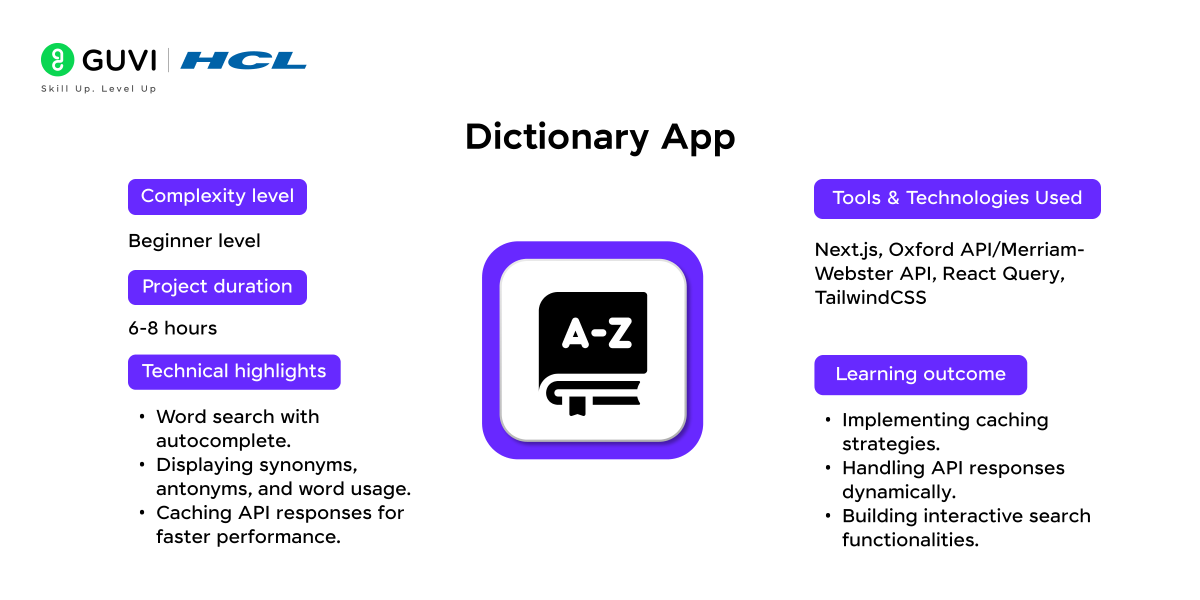
Project Complexity: Beginner
Development Time: 6-8 hours
Integration with APIs: Dictionary API (e.g., Merriam-Webster)
Tools and Technologies used: Next.js, Oxford API/Merriam-Webster API, React Query, TailwindCSS
Technical Highlights:
- Word search with autocomplete.
- Displaying synonyms, antonyms, and word usage.
- Caching API responses for faster performance.
Learning Outcomes:
- Implementing caching strategies.
- Handling API responses dynamically.
- Building interactive search functionalities.
Source Code: GitHub Repository
17. Weather Monitoring Dashboard
A weather monitoring app displays live weather data based on the user’s location and preferences. Using Next.js, this project highlights geolocation integration, responsive design, and API calls to weather services.
This app is a good choice for learning about real-time data handling and personalized content.
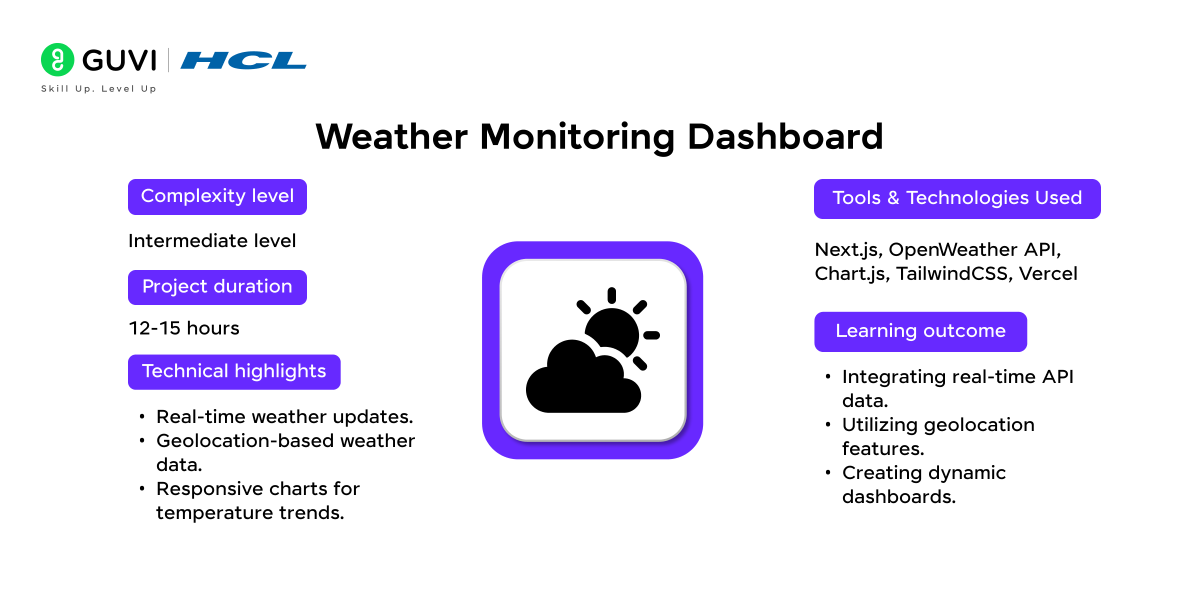
Project Complexity: Intermediate
Development Time: 12-15 hours
Integration with APIs: OpenWeatherMap API
Tools and Technologies used: Next.js, OpenWeather API, Chart.js, TailwindCSS, Vercel
Technical Highlights:
- Real-time weather updates.
- Geolocation-based weather data.
- Responsive charts for temperature trends.
Learning Outcomes:
- Integrating real-time API data.
- Utilizing geolocation features.
- Creating dynamic dashboards.
Source Code: GitHub Repository
18. Daily Activity Planner App
Build an activity planner with drag-and-drop scheduling features, where users can organize their daily tasks. This project provides insights into task management, drag-and-drop functionality, and state management.
It’s great for beginners to intermediate learners who want to enhance their skills in user interaction design and efficient state handling.
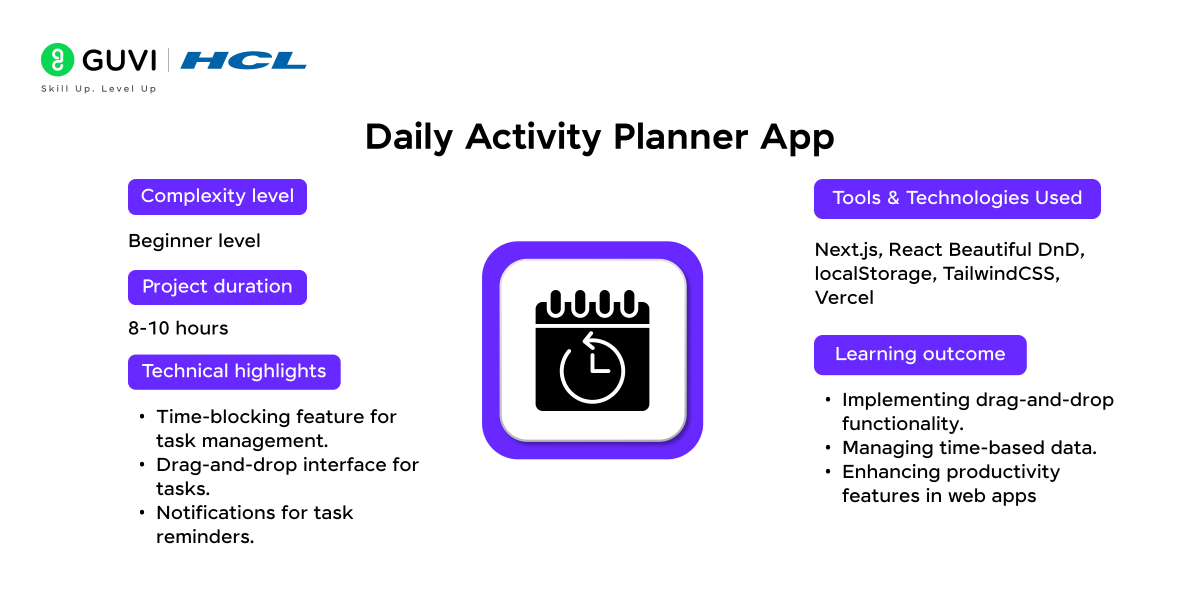
Project Complexity: Beginner
Development Time: 8-10 hours
Integration with APIs: Optional
Tools and Technologies used: Next.js, React Beautiful DnD, localStorage, TailwindCSS, Vercel
Technical Highlights:
- Time-blocking feature for task management.
- Drag-and-drop interface for tasks.
- Notifications for task reminders.
Learning Outcomes:
- Implementing drag-and-drop functionality.
- Managing time-based data.
- Enhancing productivity features in web apps.
Source Code: GitHub Repository
Final Words
Building Next.js projects is one of the most effective ways to strengthen your understanding of modern web development. Each project in this list offers unique challenges and insights, ensuring a comprehensive learning experience.
From beginner-friendly tools like a Calculator App to advanced solutions like a Real-time Notification System, these Next.js project examples offer a comprehensive learning experience. By working through these projects, you’ll gain hands-on knowledge of the Next.js project structure and its integration capabilities.
If you have any doubts about any of the projects or the article, do reach out to us in the comments section below.
FAQs
Simple projects like a personal portfolio, a blog with Markdown support, or a basic e-commerce store are ideal for beginners in Next.js.
Next.js projects help beginners grasp React concepts, server-side rendering, and static site generation, providing a solid foundation for modern web development.
Beginners can learn React fundamentals, routing, API integration, SEO optimization, and performance enhancements using Next.js.
A personal portfolio website is a great starting point, as it covers basic React components, styling, and deployment.
It usually takes 1-2 weeks to complete a beginner-level project, depending on the complexity and the learner’s pace.





















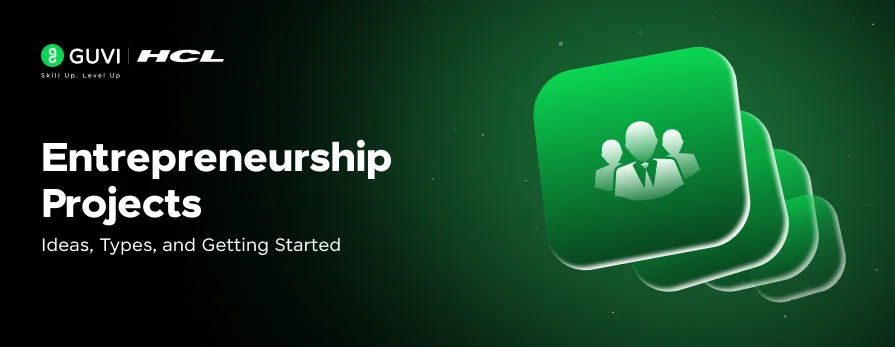

![Top 10 React Native Project Ideas [With Source Code] 21 React Native Project Ideas](https://www.guvi.in/blog/wp-content/uploads/2024/10/React_Project_Ideas.png)

![Top 9 AWS Projects for Beginners with Source Code [2025] 22 aws project](https://www.guvi.in/blog/wp-content/uploads/2025/07/aws-project.png)
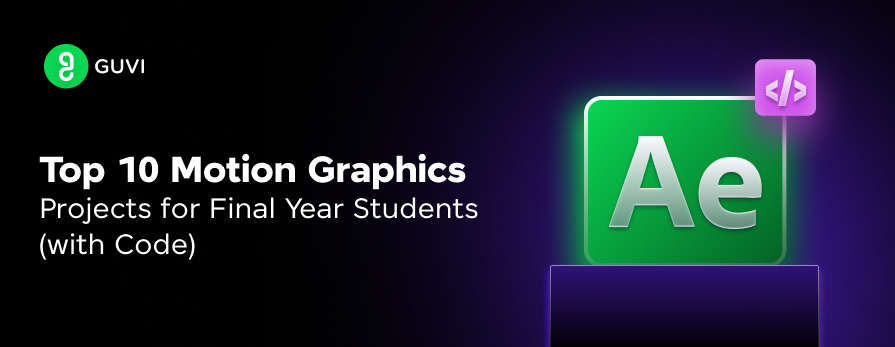
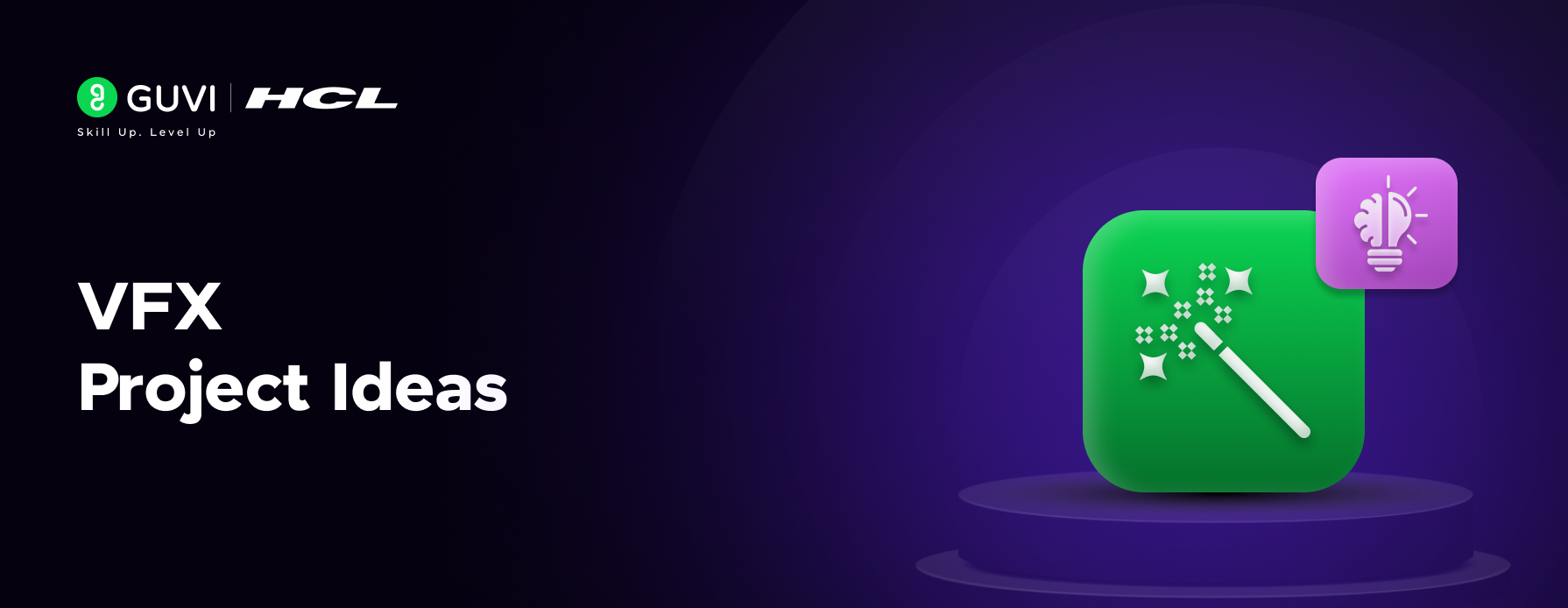
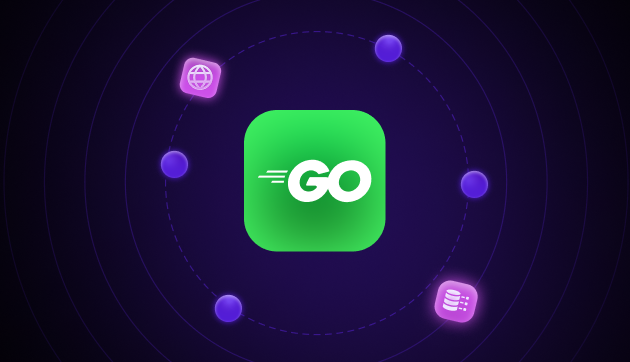
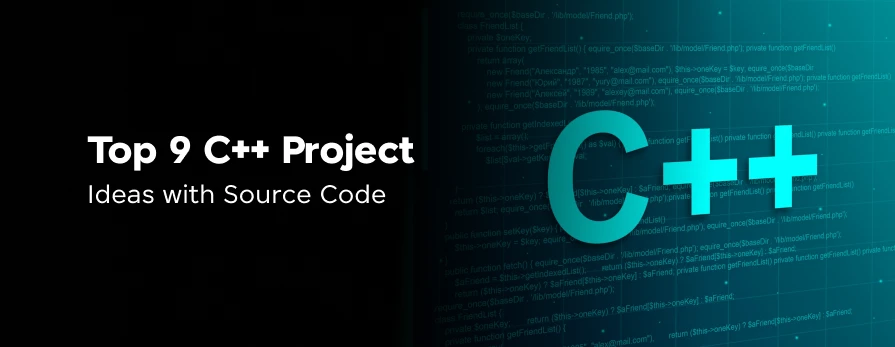

Did you enjoy this article?